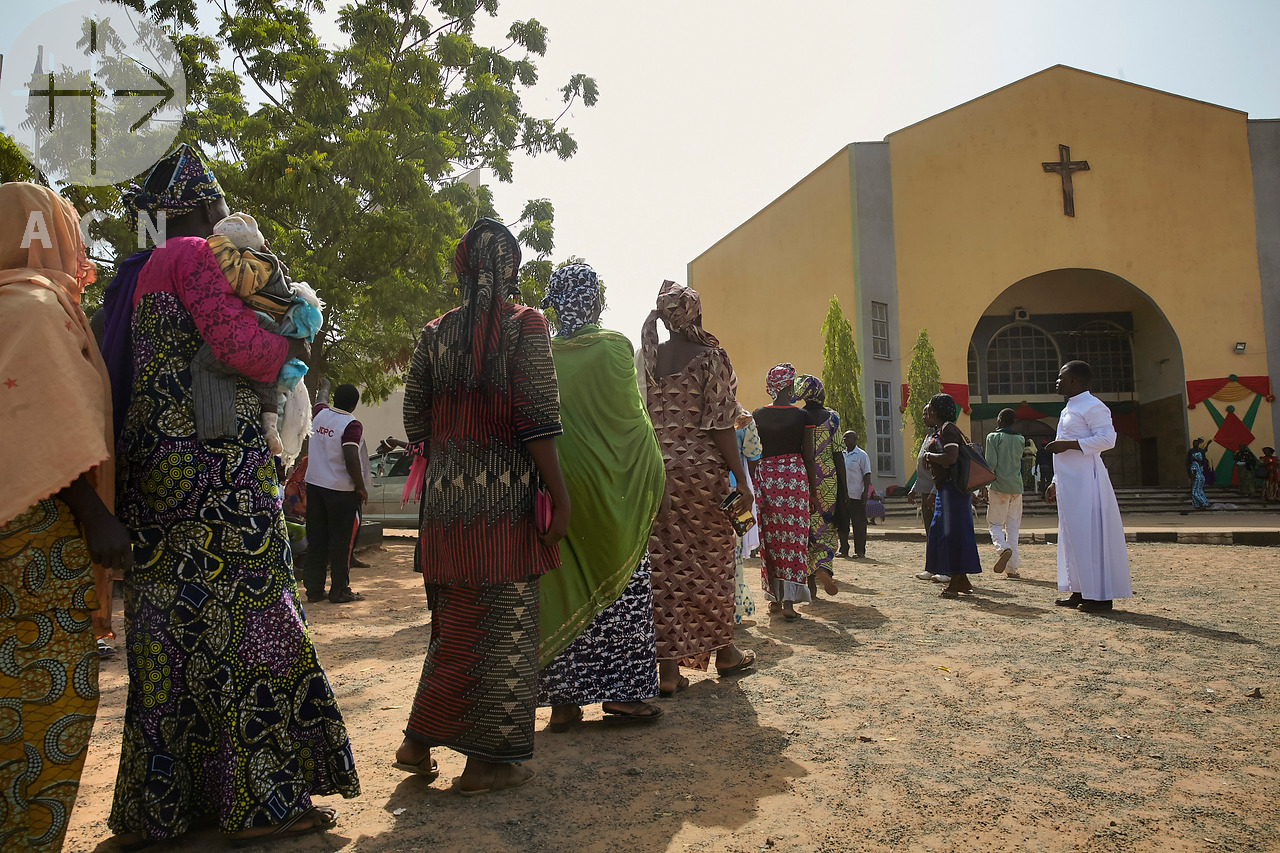(ZENIT News / Rome, 06.03.2023).- The <2022> Pontifical Yearbook and the 2021 Annuarium Statisticum Ecclesiae, edited by the Central Office of Ecclesiastical Statistics, and published by the Libreria Editrice Vaticana, are already in bookstores.
The Pontifical Yearbook offers information on the life of the Catholic Church in the world, from December1, 2021 to November 30, 2022.
During this period, four Bishoprics were erected (three Dioceses and one Eparchy); two dioceses were united; a territorial Prelature was raised to a diocese; and a diocese became and Apostolic Exarchate.
The Annuarium Statisticum Ecclesiae provides data on the principal dynamics that characterize pastoral action in the Catholic Church in the 3,030 ecclesiastical circumscriptions of the world.
Following are some notes on the quantitative aspects that seem to constitute the clearest and most important tendencies of the Catholic Church between 2020 and 2021.
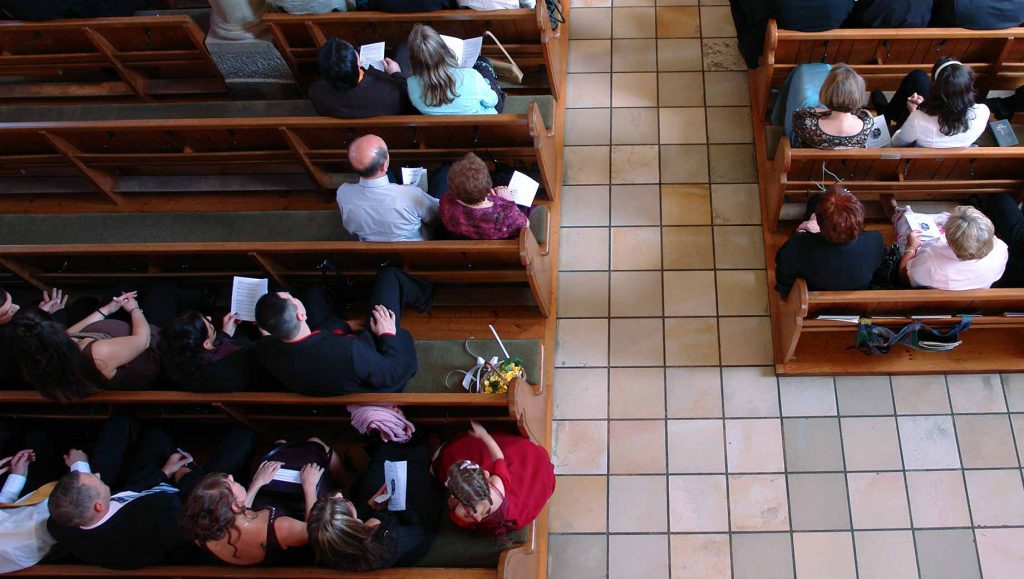
Number of Catholics in the World
At the global level, the number of baptized Catholics went from 1,360 million in 2020 to 1,378 in 2021, which implied a relative variation of +1.3%. This increase was slightly less to that of the Earth’s population, which went from 7,667 to 7,786n million in the same period, a positive variation of 1.6%.
These increases are attributed differentially to the different Continental situations: whereas in Africa there was an increase of 3.1% in the number of Catholics, at the other extreme a situation exists of practical stability in Europe; there were also increases in Asia (+0.99%) and America (+1.01%).
Percentage of Catholics Relative to the World Population
In 2021 Catholics represented 17.67% of the world population. The proportion of Catholics in the population has remained practically unchanged in the last years, thus reflecting substantial stability in the diffusion of Catholics. It’s also important to point out that the greater proportion was in America with 64.1 Catholics for every 100 inhabitants, followed by Europe with 39.6 Catholics, Oceania with 25.9 and Africa with 19.4; the lowest incidence occurred in Africa with 3..3 Catholics for every 100 inhabitants, due, as is well known, to the great diffusion in this Continent of non-Christian Confessions.
Noting the number of Catholics present in the different Continental areas over the global total, the tendency is confirmed of the increase of Africa’s weight (whose Catholics went from 18,9% to 19,3% of the global total) in the biennium considered, whereas Europe’s weight diminished, whose percentage of the global total dropped by three percentage points in 2021, from the 21.1% in 2020.
Although there was a slight decline in 2021, America continues being the Continent to which 48% of the world’s Catholics belong. Of these, almost 57% reside in South America, 27% in Brazil, which was confirmed as the country with the greatest number of baptized Catholics in the world: almost 180 million Brazilians profess the Catholic faith. The Asian Continent’s incidence seems to be growing moderately, with a weight of more than 59% of the planet’s population, and it remains around 11% of Catholics in the period considered. In Oceania, the weight of Catholics in the global total remained stable, although with a consistency that did not reach 0.8% of the world population.
Number of Catholic Priests in the World
The most recent data, referring to 2021, showed that the number of clergymen in the world was 462,388, with 5,340 Bishops, 407,872 priests and 49,176 Permanent Deacons. Compared with 2020, the number of clergymen decreased by 0.39%.
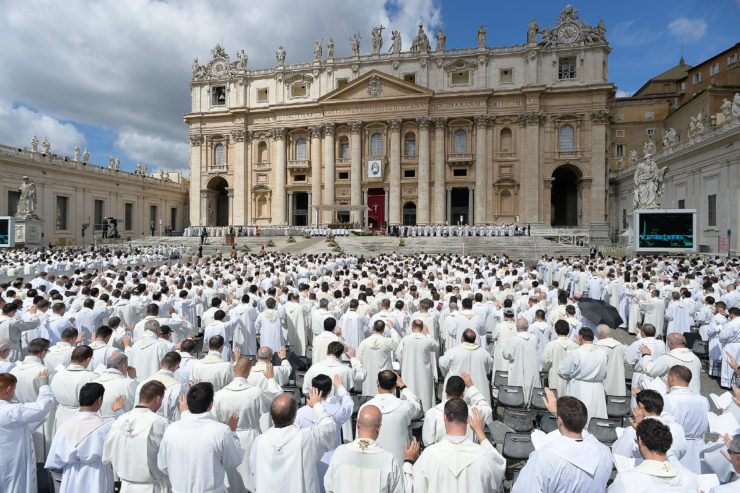
Number of Bishops in the World, Catholics per Bishops and Priests per Bishop
The number of Bishops decreased from 5,363 in 2020 to 5,340 in 2021. The decrease affected America (from 2,022 to 2,000), Asia (from 810 to 806), Europe (from 1,678 to 1,676 and Oceania (from 135 to 133), whereas Africa registered an increase of 7. North America in particular registered a growth of 3 units, whereas the rest of the Continent reflected contrasting variations: virtual stability in the central part and a quite pronounced decrease (24 units) in the southern part.
The percentage incidence of Bishops by Continent remained essentially stable throughout the period considered: in 2021 in particular the entire American Continent represented 37.5% of all the world’s Bishops, followed by Europe with 31.4%, Asia with 15.1%, Africa with 13.6% and Oceania with 2.4%.
More homogenous and balanced was the distribution, by Continents, of the number of Catholics per Bishop, which went from an average of 254,000 to 258,000 between 2020 and 2021: Africa and Asia, Continents where the spread of Catholicism was more dynamic, reflected a tendency to converge towards the mean.
It is useful to evaluate the number of priests per Bishop to have an idea of the pastoral commitments that each Bishop faces in each Continent. At the global level, this proportion decreased in the course of the two years considered, going from 77 to 76 priests per Bishop, which reflected a better quantitative balance, in the Continental reality, between priests and Bishops as time passed between the beginning and end of the period of observation.
Decrease of Priests in Europe and America, Increase in Africa and Asia
The number of priests as a whole decreased from 410,219 in 2020 to 407,872 in 2021, which implied a decrease of 0.57%. However, observed when the diocesan priests and Religious Order priests were analyzed separately was that, whereas the former decreased by 0.32%, the latter decreased by 1.1%.
Variations are contrasted in the different Continents: Europe and Africa, as well as Asia, are in an antithetical position. In fact, in Europe there was a decrease both of diocesan priests as well as of Religious Order priests (also in America there was a decrease in both groups of Priests), in Africa and Asia, on the contrary, there was an increase in priests of both groups. In Africa, the number of diocesan priests went from 35,561 to 36,535, a relative increase of 2.74%, whereas the number of Religious Order priests increased by 3.65%. In Asia, the number of priests registered a global growth of 1.0% during the biennium examined. In Oceania, there was an increase of only 0.2%; however, in this Continent the relatively low number of priests made the impact less and the quota of 4,496 priests in 2020 increased to 4,507 in 2021.
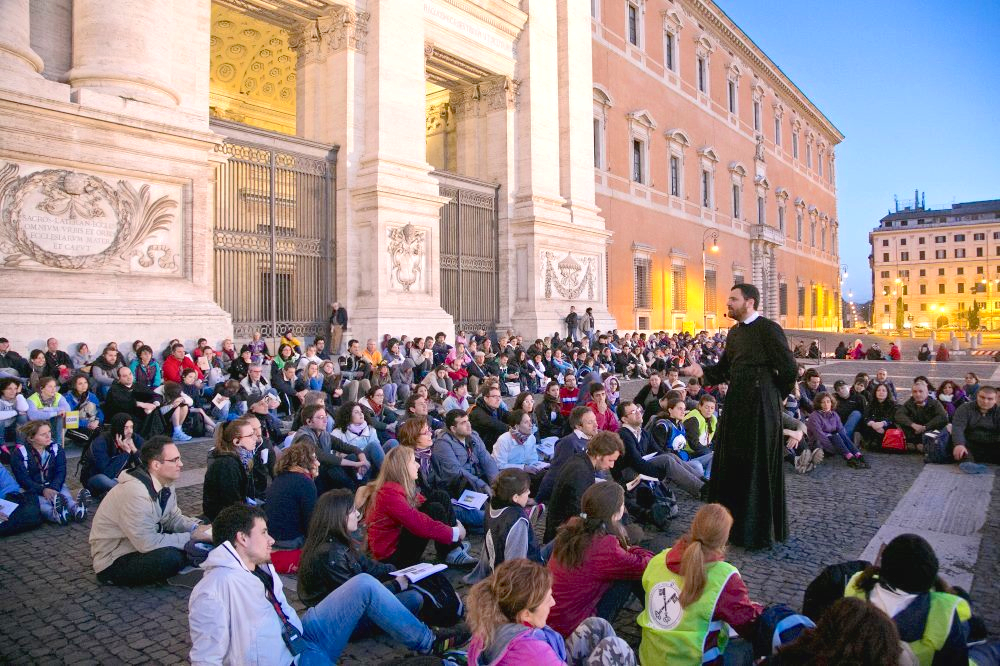
Priests per Continent
The percentual distribution of priests per Continent reflected appreciable changes in the biennium considered. Despite having the highest quota, witnessed over time was the decrease in the number of priests over the total: in 2020 the 164,000 priests implied almost 40% of the total of the ecclesiastical collective, whereas a year later, it dropped to a quota of 39.3%. For their part, Africa and Asia gained ground, reaching a joint quota of 30.3% of the global total in 2021, as opposed to 29.6% in 2020. America and Oceania maintained a stable percentual quota of 29%and slightly more than 1% respectively.
Number of Catholics per Priest
The differences between the distribution of Catholics and priests, as well as the different temporal dynamics made manifest for these tow characters, implied a marked variability of the pastoral burden understood as the relation between the number of Catholics and the number of priests: at the global level, this index went from 3,314 in 2020 to 3,373 in 2021. In comparison with the average global value, the heaviest burdens were in 2021 in America (5,534) and Africa (5,101). With values lower than the world average were Oceania (with 2,437 Catholics per priest), Asia (2,137) and Europe (1,784).
Increase in the Number of Permanent
The population of Permanent Deacons, both diocesan as well as religious, also showed a significant and encouraging evolutive dynamic in the biennium 2020-2021: the number in the world went from 48,635 to 49,176, with a relative increase of 1.1%. The increase happened everywhere, but the rates of growth differed from one Continent to another. Europe and America reflected the most significant numerical consistencies. The number of European Deacons, in fact, with 15,170 in 2020 reached 15,438 in 2021.
In America the consistency of 32,226 in 2020 rose to 32,373 in 2021. Concentrated in these two Continents alone was more than 97% of the planet’s global population, whereas the rest was divided between Africa, Asia and Oceania. In Asia and Oceania, in particular, the rhythm of growth was gentler. Such a differentiated growth of the different Continents has made the percentual importance of Deacons move, and not a little in the course of the period considered: for example, at the beginning of the period the rate in Europe was 31.2% of the planetary total, in 2021 it rose to 31.4%. Correlatively, in America, where there is another important group of Permanent Deacons, a decrease was reflected in the relative weight (from 66.3% to 65.8%).
Clergymen’s pastoral activity was flanked by other numbers of Religious labourers: we dedicate to them the following observations.

Number of Professed Religious Not Priests
The tendency continued of a decrease that for several years affected the group of professed Religious not priests, who in 2020 were 50,569 in the whole world, and dropped to 49,774 in 2021, with a variation of (-10.3%), stationary in Asia, the professed Religious not priests increased in Africa (+2.2%), where their participation in the global total continued to increase. The weight of professed Religious not priests in Africa and Asia reached 71% more than in America. Europe continued to have the relatively highest quota (27.9%), but decreased in relation to 2020.
Total Number in General of Professed Men and Women Religious
The total number of professed Religious in 2021 was 608,958, close to 33% present in Europe, followed by Asia with 175,494 consecrated Religious and America with 145,206. Compared with 2020, the group decreased by 1.7%. The decrease affected three Continents (Europe, America and Oceania) with negative and significant variations (around -3.5%). Consequently, the fraction of women religious in Africa and Asia, whose incidence as a whole decreased from 57.8% to 56.7%.
Number of Major Seminarians
The temporal tendency of the number of major seminarians observed in the world since 2013, reflects an uninterrupted decrease, which continued in 2021.
In that year, the number of seminarians was 109,895, 61% of whom were diocesan seminarians and the remaining 39% were Religious. Compared with 2020, there was a decrease of 1.8%. The decrease occurred in almost all the territorial divisions: the number of seminarians increased only in Africa, where there was an increase of just over 0.6% between 2020 and 2021.
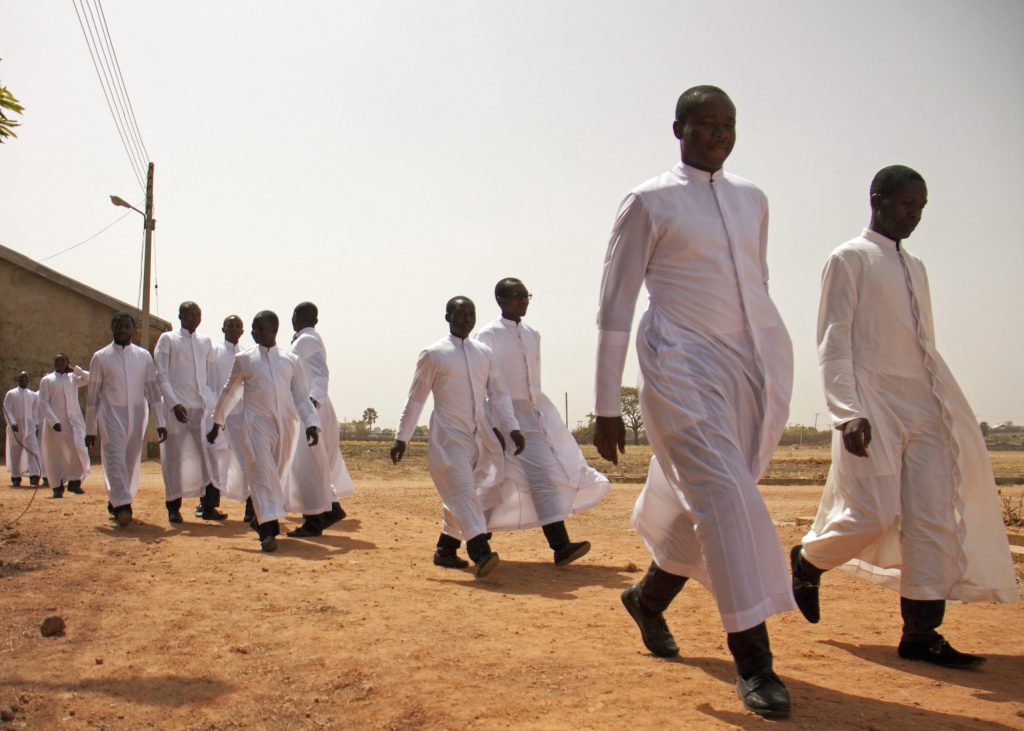
North America reflected a quite pronounced tendency to decrease. (-5.8% in the biennium considered). For its part, the rest of the Continent reflected a lesser decrease (-1.8%). In Europe and Asia seminarians decreased by 5.8% and of 1.6% in the biennium, respectively. Consequently, a reduction is observed in the role of the European Continent in the potential growth of priestly renewal, with a decrease of its quota of 13.6% slightly more than 13% of the global total. North America’s weight also decreased, which went from a quota of 4.6% in 2020 to 4.4% in 2021. The quota of the rest of the American Continent remained practically invariable in the biennium. Instead, the weight of Africa and Asia increased, which reached a total of 60.1% of the total of major seminarians. Oceania represented only 0.9% of the total, but with a slight increase.
If we compare the number of major seminarians with the number of the Catholic population, we get a rate (of vocations), which makes even clearer the magnitude of the level of vocations reached at the end of the biennium. In 2020 there were in the whole of the Continent 8.23 major seminarians for every 100,000 Catholics and the final number for 2021 was 7.99. The most favourable situation in 2021 was in Asia (with 20.96 seminarians for every 100,000 Catholics), Africa (with 12.75) and Oceania (8.76). Much lower was the rate of vocations in the remaining divisions where the value of 5.01 for Europe contrasts with that of 4.13 for South America.
Vocations per Number of Priests
In relation with the current number of priests, vocations also decreased. Whereas in 2020 the number of candidate worldwide was 27,27 for every 100 priests, in 2021 the proportion decreased to 26.94. This indicator, which can be interpreted as a measure of the potential of generational sustainability in actual pastoral service, was diversified by continental areas. In fact, comparing the values observed in 2021 in the different Continents with the equal threshold value of 12.5 seminarians for every 100 priests in 2021, continues being the only continental area below the percentage of substitution, thus confirming the continuation of a situation of regression in priestly vocations, which decreased by 888 units from 2020. The Continent with the most favourable quotient continues being the African, where for every 100 current priests, more than 65 seminarians attended philosophy and theology seminars in 2021, and the Asian (with 44.79 seminarians for every 100 priests). At the level of Sub-Continents, North America is also below the threshold value, with a quotient of seminarians for priests of 11.21%.
With information from L’Osservatore Romano. Translation of the Italian original into Spanish by ZENIT’s Editorial Director and, into English, by Virginia M. Forrester


